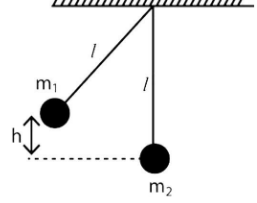
Answer
357k+ views
Hint: To solve this problem first of all we will find the initial velocity of the first mass which is present at height h then we will apply the moment conservation in order to get the final velocity of the combined system. At last we will substitute the value in order to get the ratio of their masses.
Complete step by step answer:
Let's have a quick overview of the pendulum before moving on to the question. A pendulum is a weight that may freely swing and is suspended from a pivot. Gravity operates as a restorative force when a pendulum is shifted sideways from its resting, equilibrium position, propelling the pendulum back to its equilibrium position.
Let us now attempt to answer the question;
So, for mass ${m_1}$ :
Velocity of mass \[{m_1}\] just before collision \[v = \sqrt {2gh} \]
After collision, the combined mass \[\left( {{m_1} + {m_2}} \right)\] moves with a common velocity \[V\] and reaches a height $\dfrac{h}{4}$ .
Using momentum conservation just before and after a collision: ${P_i} + {P_f}$
${m_1}v + 0 = \left( {{m_1} + {m_2}} \right)V \\
\Rightarrow {m_1}\sqrt {2gh} = \left( {{m_1} + {m_2}} \right)V \\
\Rightarrow V = \dfrac{{{m_1}\sqrt {2gh} }}{{{m_1} + {m_2}}}\,\,\,\,\,..........\left( 1 \right) \\ $
$\dfrac{{{m_1}\sqrt {2gh} }}{{{m_1} + {m_2}}} = \dfrac{{\sqrt {2gh} }}{2} \\
\Rightarrow {m_1} = {m_2} \\ $
Using the relation
$V = \sqrt {2g \times \dfrac{h}{4}} = \dfrac{{\sqrt {2gh} }}{2}\,\,in\left( 1 \right) \\
\Rightarrow \dfrac{{{m_1}\sqrt {2gh} }}{{{m_1} + {m_2}}} = \dfrac{{\sqrt {2gh} }}{2} \\
\therefore {m_1} = {m_2} \\ $
So, the correct option is A.
Note:Students should be very careful while solving these types of problems related to momentum conservation because momentum is conserved only when there is no external force acting on the system. If there was external force then we would have applied the other method.
Complete step by step answer:
Let's have a quick overview of the pendulum before moving on to the question. A pendulum is a weight that may freely swing and is suspended from a pivot. Gravity operates as a restorative force when a pendulum is shifted sideways from its resting, equilibrium position, propelling the pendulum back to its equilibrium position.
Let us now attempt to answer the question;
So, for mass ${m_1}$ :
Velocity of mass \[{m_1}\] just before collision \[v = \sqrt {2gh} \]
After collision, the combined mass \[\left( {{m_1} + {m_2}} \right)\] moves with a common velocity \[V\] and reaches a height $\dfrac{h}{4}$ .
Using momentum conservation just before and after a collision: ${P_i} + {P_f}$
${m_1}v + 0 = \left( {{m_1} + {m_2}} \right)V \\
\Rightarrow {m_1}\sqrt {2gh} = \left( {{m_1} + {m_2}} \right)V \\
\Rightarrow V = \dfrac{{{m_1}\sqrt {2gh} }}{{{m_1} + {m_2}}}\,\,\,\,\,..........\left( 1 \right) \\ $
$\dfrac{{{m_1}\sqrt {2gh} }}{{{m_1} + {m_2}}} = \dfrac{{\sqrt {2gh} }}{2} \\
\Rightarrow {m_1} = {m_2} \\ $
Using the relation
$V = \sqrt {2g \times \dfrac{h}{4}} = \dfrac{{\sqrt {2gh} }}{2}\,\,in\left( 1 \right) \\
\Rightarrow \dfrac{{{m_1}\sqrt {2gh} }}{{{m_1} + {m_2}}} = \dfrac{{\sqrt {2gh} }}{2} \\
\therefore {m_1} = {m_2} \\ $
So, the correct option is A.
Note:Students should be very careful while solving these types of problems related to momentum conservation because momentum is conserved only when there is no external force acting on the system. If there was external force then we would have applied the other method.
Recently Updated Pages
How many sigma and pi bonds are present in HCequiv class 11 chemistry CBSE

Mark and label the given geoinformation on the outline class 11 social science CBSE

When people say No pun intended what does that mea class 8 english CBSE

Name the states which share their boundary with Indias class 9 social science CBSE

Give an account of the Northern Plains of India class 9 social science CBSE

Change the following sentences into negative and interrogative class 10 english CBSE

Trending doubts
Difference Between Plant Cell and Animal Cell

Difference between Prokaryotic cell and Eukaryotic class 11 biology CBSE

Fill the blanks with the suitable prepositions 1 The class 9 english CBSE

Differentiate between homogeneous and heterogeneous class 12 chemistry CBSE

Which are the Top 10 Largest Countries of the World?

One cusec is equal to how many liters class 8 maths CBSE

Give 10 examples for herbs , shrubs , climbers , creepers

The mountain range which stretches from Gujarat in class 10 social science CBSE

The Equation xxx + 2 is Satisfied when x is Equal to Class 10 Maths




